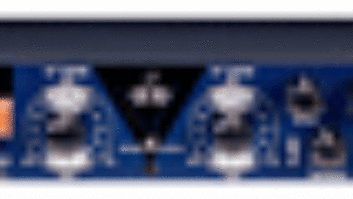In the past decade, the substantial demand for tube-based outboard gear has driven prices in the vintage gear market steadily upward. As a result, those of us seeking the “warmth and musicality” that vintage gear can provide are finding more options in the “vintage style” new gear hitting the market. Requisite Audio is one vendor that has answered this demand with a single-channel, all-tube combination preamplifier/optical limiter appropriately named the PAL.
The DesignIn developing the PAL, Requisite Audio owner/lead designer Danny McKinney combined features of Requisite’s Y7 preamp and its L1 classic style optical limiter into a single 2-rackspace package priced at $2,300. The units are handcrafted and point-to-point hand-wired using the highest quality components. All transformers are based on classic designs and upgraded wherever appropriate. The only circuit boards used in the PAL are for non-audio functions such as power supply components.
operation of the PAL is simple. Inputs include mic, line-level and a Hi-Z direct input that is accessible on the front panel. Controls include a toggle for selecting line or mic sources (the Hi-Z input is also active in mic mode); a -20dB mic input pad; phantom power switch; and another switch for choosing output or gain reduction display on the Vu meter. Two PALs can be linked for stereo applications with a 11/44-inch jack and a Link mode switch.
Three large knobs control the mic/DI input gain, peak reduction and output level. Compression ratios are variable between 10:1 and 3:1, with the peak reduction knob increasing the amount of gain reduction. At the 10:1 ratio, the PAL exhibits mild compression until the program level reaches -20 dB, at which point the limiting function actually hits 10:1. The PAL can provide as much as 68 dB of gain in the mic mode and up to 13 dB of gain in the limiter mode, and drive at +26 dB before clipping.
The Soundusing the PAL as a vocal mic preamp with a u67 into an Apogee AD-8000, we tracked a female vocalist for a project on a local label. I began with the peak level set fully counterclockwise to hear how the vocal would sound with minimal compression. The results were amazingly clear, detailed and without coloration. Varying the settings between the input, peak and output gain stages allowed me to bring out subtle amounts of airiness in her voice. Toggling between both of the compression ratios, the clarity remained.
For a test on a mono instrument, an acoustic bass miked with a u67 into the PAL was big and open sounding. The low end was round and pronounced-even without the use of a DI on the bass-with the transient sounds of the strings crisp and clear. Tweaking the compression settings worked some interesting sustain effects into the mix.
Calibrating two PALs in Link mode as a stereo pair was easy. We decided to record some live drums using a minimal mic setup. With the RE20 kick and SM57 snare going into a Neve 1272 preamp, we routed a pair of KM56s through the PALs as a pair of X/Y overheads and let the tweaking begin. The clarity and detail were fantastic. Experimenting with compression settings, gain input and muting of the snare and kick created a rich-sounding live room ambience that momentarily made me think I was Rudy Van Gelder. The PALs really worked well in this situation.
Next, we ran some material through the Hi-Z DI inputs, beginning with a mono source. A Music Man Stingray bass through the DI sounded crisp, with the limiting smoothing it out nicely. The sound was not quite as crunchy as I would normally want for electric bass, so the PAL probably wouldn’t be my first choice for this application.
Working with stereo drum loops on a Korg Triton going through the DI inputs, we wanted to see what the PAL would add in terms of presence and detail. Results at the initial settings (peak level gain turned counterclockwise) were predictably warm and clear. However, we really had a lot of fun tweaking the input gain and slamming the compression into gear. A nice, clean, puffy texture to the sound added a whole new dimension to the drum loops.
For a final test, we wanted to see how the PALs sounded in a line-level situation. We sent a 2-channel final mix of a song through the linked units to hear how it compared to some of our favorite stereo compressors (a Manley Vari-Mu and a Focusrite Red 3). The overall sound of the PALs was extremely clean at the initial uncompressed stage. For an hour, we tried various settings in an attempt to make the unit distort. only by slamming the gain at a very high compression output in a 10:1 ratio did the PALs start to sound remotely unnatural. In comparison to the Manley and Focusrite, it affects program material in a much more natural-sounding way, while adding a bit of body to the low end. Very musical and pleasing.
The VerdictIf you’re looking for a clean, natural- sounding preamp/compressor combo, the PAL is a good choice for your rack. As a mic preamp, the all-tube design is impeccably built to add depth and clarity with dynamic control that is very natural sounding. As a line-level amplifier and bus compressor, two linked PALs provide an option for ultra-clean compression on 2-channel material. With this in mind, it would be hard to buy just one. In fact, I thought these sounded so good that I had to buy two for myself…
Requisite Audio, 2645 E. Glenoaks Blvd., Glendale, CA 91206; 818/247-2047; fax 818/247-4498; www.requisiteaudio.com.







